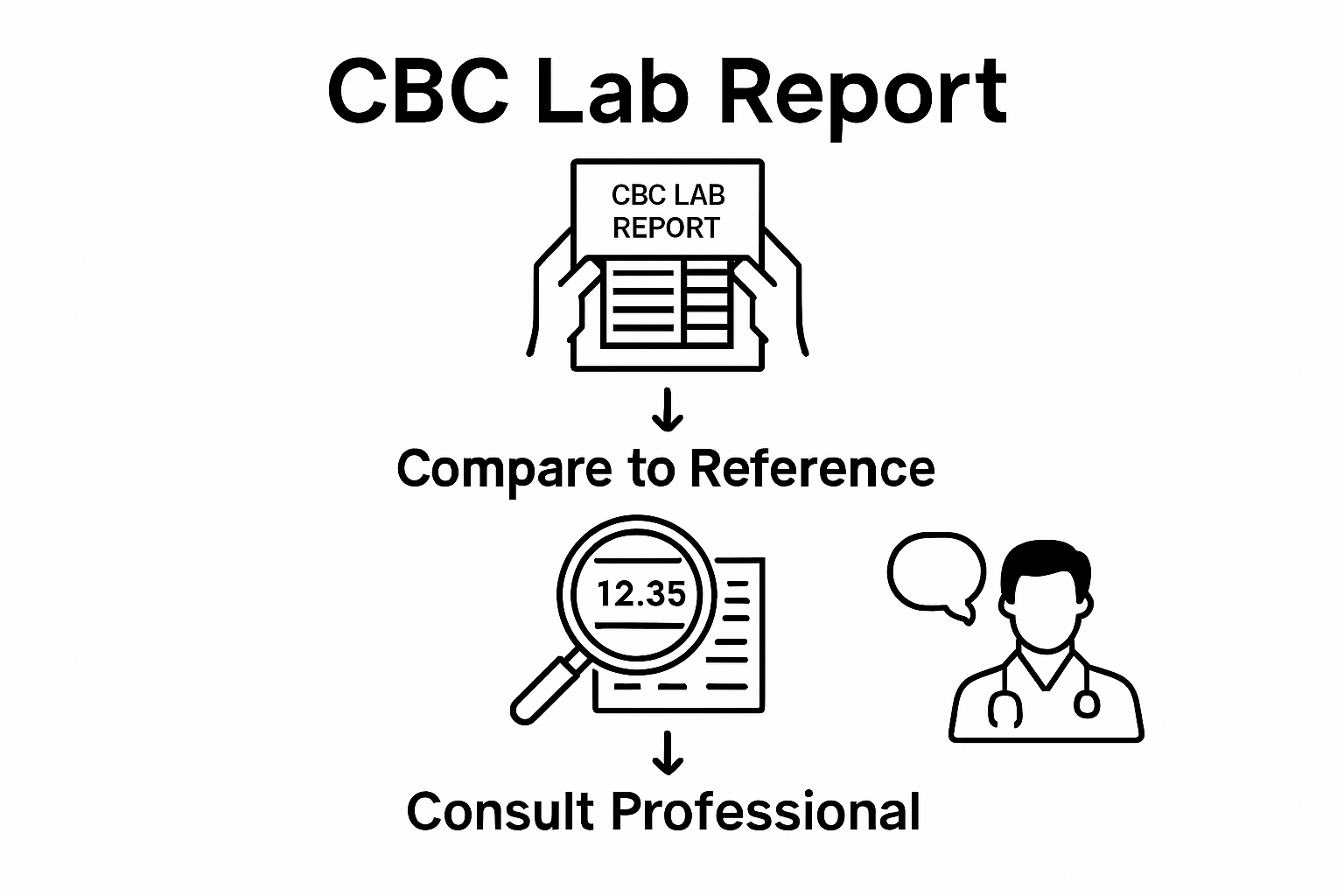Marijuana
How Do I Read My CBC Results: A Step-by-Step Guide
Trying to make sense of your CBC results can feel like reading a secret language. Most people are handed a sheet filled with numbers and medical terms, only to find themselves more confused than before. But here is a surprising fact. About 10 to 20 percent of CBC tests come back abnormal yet not every abnormal number means there is something seriously wrong. Sometimes the real insight comes from pairing those numbers with the tiny details you might miss.
Table of Contents
- Step 1: Gather Your CBC Results And Lab Report
- Step 2: Identify Key Components Of CBC Results
- Step 3: Compare Your Values To Reference Ranges
- Step 4: Recognize Symptoms Indicated By Abnormal Results
- Step 5: Consult With A Healthcare Professional For Interpretation
- Step 6: Take Action Based On Professional Guidance
Quick Summary
| Key Point | Explanation |
|---|---|
| 1. Gather Your CBC Lab Report | Access your recent CBC report digitally or request it from your provider to understand your health metrics. |
| 2. Understand Key CBC Components | Familiarize yourself with RBC, WBC, hemoglobin, and platelets to interpret health implications effectively. |
| 3. Compare Values to Reference Ranges | Analyze your CBC values against reference ranges to identify potential health concerns accurately. |
| 4. Recognize Symptoms of Abnormal Results | Be aware of symptoms like fatigue or increased bruising that may indicate underlying conditions related to your CBC results. |
| 5. Consult a Healthcare Professional | Discuss your results and symptoms with a healthcare provider for accurate interpretation and action planning. |

Step 1: Gather Your CBC Results and Lab Report
Reading your CBC (Complete Blood Count) results begins with collecting the actual lab report. This critical first step determines how effectively you can understand and interpret your blood test findings. Your CBC report contains a wealth of information about your overall health, providing detailed insights into various blood components and their measurements.
Obtaining Your Lab Report
The process of gathering your CBC results typically involves multiple potential pathways. Most healthcare providers now offer digital access through online patient portals, which provide convenient and immediate retrieval of medical documents. If you have an established online account with your clinic or hospital, log in and navigate to the laboratory or test results section. Look for a recent CBC report, which will include a comprehensive breakdown of your blood test values.
For patients who prefer traditional methods or do not have digital access, directly contacting your healthcare provider’s office remains an excellent strategy. Request a physical or electronic copy of your complete CBC report. When speaking with medical staff, specify that you need the full detailed report, not just a verbal summary. This ensures you receive the comprehensive document with all numerical values and reference ranges.
Verifying Report Completeness
Before proceeding with interpretation, confirm your lab report contains essential elements. A complete CBC report should include:
- Patient name and identification details
- Date of blood draw
- Laboratory name and contact information
- Specific blood component measurements
- Reference ranges for each tested parameter
- Any additional notes or comments from the laboratory
By meticulously gathering your CBC results and ensuring you have a comprehensive report, you establish a solid foundation for understanding your blood test outcomes. Each detail matters when analyzing your personal health metrics, so patience and thoroughness are key during this initial step.
To help you verify that your CBC lab report contains all essential details before interpreting results, refer to this checklist of required items.
| Requirement | Description |
|---|---|
| Patient name and ID details | Confirms you are viewing your own medical information |
| Date of blood draw | Ensures results are current and relevant |
| Laboratory name and contact info | Provides source for follow-up or verification |
| Detailed blood component measurements | Lists results for each tested blood component |
| Reference ranges per parameter | Offers benchmarks for normal vs. abnormal values |
| Additional lab notes or comments | Supplies context or laboratory-specific insights |
According to MedlinePlus, obtaining your complete lab report is the essential first step in comprehending your blood test results accurately and effectively.
Step 2: Identify Key Components of CBC Results
Understanding your CBC results requires familiarity with the key blood components measured during the test. This critical step transforms a complex medical document into a comprehensible overview of your current health status. Your CBC report provides a comprehensive snapshot of your blood’s essential elements, each offering unique insights into your overall physiological functioning.
Breaking Down Blood Components
A Complete Blood Count measures several critical parameters that collectively paint a detailed picture of your health. Red Blood Cell (RBC) Count represents the number of oxygen-carrying cells circulating in your bloodstream. This measurement helps assess your body’s ability to transport oxygen effectively and can indicate potential conditions like anemia or polycythemia. Alongside RBC count, hemoglobin levels reveal the protein responsible for oxygen transportation, with low levels potentially signaling nutritional deficiencies or underlying health challenges.
White blood cells form another crucial component of your CBC results. These immune system defenders protect your body against infections and diseases. An abnormal white blood cell count can suggest immune system responses, ranging from ongoing infections to more complex immune disorders. Platelet count rounds out the primary measurements, indicating your blood’s clotting capabilities. Too few or too many platelets can signal potential bleeding disorders or other medical conditions requiring further investigation.
The hematocrit percentage provides additional context by measuring the proportion of red blood cells in your total blood volume. This metric helps healthcare professionals understand your blood’s concentration and potential fluid balance issues. Variations from standard ranges might indicate dehydration, nutritional challenges, or more complex health conditions.
Practical interpretation requires comparing your specific values against established reference ranges. These ranges vary slightly based on factors like age, sex, and individual health characteristics. Subtle deviations might not always indicate serious medical concerns, but significant differences warrant professional medical consultation.
According to the Mayo Clinic, understanding these key CBC components provides a foundational approach to interpreting your blood test results accurately and comprehensively.
Step 3: Compare Your Values to Reference Ranges
Comparing your CBC test results against established reference ranges transforms raw numbers into meaningful health insights. This critical step helps you understand whether your blood components fall within expected parameters or potentially signal underlying health conditions. Reference ranges serve as a standardized medical benchmark, providing context for interpreting your individual test results.
Understanding Reference Range Interpretation
Every CBC report includes reference ranges specific to each blood component, typically displayed alongside your individual test values. These ranges represent the expected normal measurements for healthy individuals, accounting for variations based on factors like age, sex, and overall health status. When examining your results, look for values marked in standard black text, which typically indicate normal ranges. Highlighted or bolded values often signify measurements outside the expected parameters, potentially requiring further medical investigation.
Interpreting reference ranges requires a nuanced approach. Not every value outside the standard range automatically indicates a serious medical condition. Minor fluctuations can result from numerous factors, including recent illness, stress, dietary changes, or natural biological variations. Mild deviations might simply reflect temporary physiological adjustments rather than chronic health issues. However, significant differences between your test results and reference ranges warrant professional medical consultation.
To effectively compare your values, create a systematic approach. Start by identifying each blood component’s specific reference range on your lab report. Carefully note your individual measurements and compare them to these established standards. Pay particular attention to components showing substantial variations from the expected range. Look for patterns or consistent deviations across multiple blood parameters, as these might provide more comprehensive insights into your overall health status.

Remember that reference ranges can vary slightly between different laboratories and medical facilities. Some reports include multiple reference ranges accounting for different demographic factors like age and sex. When in doubt, consult with your healthcare provider for a professional interpretation of your specific results.
According to the Mayo Clinic, understanding reference ranges is crucial for accurately interpreting your Complete Blood Count results and gaining meaningful health insights.
Step 4: Recognize Symptoms Indicated by Abnormal Results
Recognizing the symptoms associated with abnormal CBC results transforms numerical data into meaningful health insights. This critical step helps you understand how variations in your blood components might manifest as physical experiences, potentially signaling underlying health conditions that require professional medical attention.
Connecting Blood Test Results to Physical Symptoms
Abnormal blood test results often correspond to specific physical symptoms that provide tangible evidence of potential health challenges. Low red blood cell counts, for instance, frequently translate into persistent fatigue, unexplained weakness, and shortness of breath. These symptoms suggest your body might be struggling to efficiently transport oxygen throughout your system. Individuals experiencing these sensations might notice decreased physical endurance, difficulty concentrating, and an overall sense of exhaustion that persists despite adequate rest.
White blood cell count variations reveal different health signals. Elevated white blood cell levels typically indicate your body is actively fighting an infection, often accompanied by fever, body aches, and general inflammation. Conversely, abnormally low white blood cell counts might suggest your immune system is compromised, making you more susceptible to frequent infections and slower healing processes. Pay attention to recurring illnesses, prolonged recovery periods, or unexplained bruising and bleeding, as these could represent significant immune system variations.
Platelet count abnormalities present unique symptomatic patterns. Low platelet counts might result in increased bruising, prolonged bleeding from minor cuts, or spontaneous nosebleeds. Higher platelet levels could indicate potential blood clotting risks, manifesting through symptoms like unexplained swelling in extremities, persistent headaches, or cardiovascular discomfort. While these symptoms might seem subtle, they represent critical warning signs that warrant professional medical evaluation.
Remember that symptoms can vary widely between individuals, and not all abnormal results immediately signify serious medical conditions. Context matters significantly. Factors like recent illnesses, stress levels, dietary changes, and overall health history contribute to interpreting your specific symptoms. Consistent tracking of these physical experiences alongside your CBC results provides your healthcare provider with comprehensive insights.
According to the Mayo Clinic, understanding the connection between blood test results and physical symptoms is crucial for proactive health management and early intervention.
Step 5: Consult with a Healthcare Professional for Interpretation
Navigating the complexities of CBC results requires professional medical expertise. While understanding your test results is important, interpreting them accurately demands specialized knowledge that only healthcare professionals can provide. This crucial step transforms your personal research into actionable medical insights that directly impact your health management strategy.
Preparing for Your Medical Consultation
Before meeting with your healthcare provider, prepare comprehensive documentation to facilitate a productive discussion. Organize your CBC report, noting specific values that seem unusual or fall outside reference ranges. Create a detailed list of any symptoms you’ve experienced that might correlate with your test results. This proactive approach demonstrates your engagement in your personal health journey and helps your healthcare provider conduct a more focused evaluation.
Scheduling a dedicated consultation allows for an in-depth review of your CBC results. Effective communication is key during this interaction. Prepare a list of specific questions about your test results, such as the potential implications of abnormal values, recommended follow-up tests, or lifestyle modifications that might address any identified concerns. Be prepared to discuss your medical history, recent health changes, and any symptoms you’ve noticed. Your healthcare provider can offer nuanced interpretations that extend beyond simple numerical comparisons.
During the consultation, expect a comprehensive review that goes beyond surface-level analysis. A skilled healthcare professional will examine your CBC results in the broader context of your overall health. They will consider factors like your age, gender, medical history, current medications, and existing health conditions. This holistic approach ensures a more accurate interpretation of your blood test results, potentially identifying subtle health patterns that might not be immediately apparent.
Remember that not all abnormal results indicate serious medical conditions. Many variations can be temporary or related to recent lifestyle changes, stress, or minor health fluctuations. Your healthcare provider can help distinguish between normal variations and potentially significant health indicators. They may recommend additional testing, lifestyle modifications, or further investigation to ensure a comprehensive understanding of your health status.
According to medical research, approximately 10% to 20% of CBC results are reported as abnormal, underscoring the importance of professional medical interpretation for accurate health assessment.
Step 6: Take Action Based on Professional Guidance
Transforming medical recommendations into practical actions represents the most critical phase of understanding your CBC results. This step moves beyond interpretation, focusing on implementing targeted strategies that address your specific health needs and potential challenges identified through your blood test.
Developing a Personalized Health Action Plan
Comprehensive medical guidance requires a proactive approach to addressing potential health concerns revealed by your CBC results. Your healthcare provider will likely recommend a tailored action plan that might include dietary modifications, lifestyle adjustments, supplementation, or additional medical interventions. These recommendations are not one-size-fits-all solutions but carefully crafted strategies designed specifically for your unique health profile.
Nutritional interventions often form a cornerstone of addressing CBC-related health recommendations. If your results indicate nutritional deficiencies, such as low iron levels or vitamin deficiencies, your healthcare provider might suggest targeted dietary changes or specific supplements. Implementing these recommendations requires careful consideration and consistent follow-through. This might involve introducing iron-rich foods, incorporating specific vitamin supplements, or adjusting your current diet to support optimal blood cell production and overall health.
Medical follow-up represents another crucial component of your action plan. Depending on your CBC results, your healthcare provider might recommend periodic retesting to monitor your progress and track any changes in your blood components. This could involve scheduling follow-up blood tests at specific intervals, undergoing additional diagnostic evaluations, or maintaining regular check-ins to assess the effectiveness of implemented interventions.
Lifestyle modifications can significantly impact your blood health. Your action plan might include recommendations for stress management, exercise routines, sleep optimization, and other holistic approaches that support overall physiological balance. These suggestions extend beyond immediate medical interventions, focusing on long-term health maintenance and potential prevention of future complications.
Maintaining clear communication with your healthcare provider throughout this process is essential. Document your progress, report any new symptoms or changes, and remain open to adjusting your action plan as needed. Remember that health management is a dynamic, collaborative process that requires ongoing engagement and proactive participation.
According to the Mayo Clinic, taking structured, professional-guided actions based on CBC results is crucial for maintaining optimal health and addressing potential underlying conditions effectively.
Take Control of Your CBC Health Journey with Natural Relief
If your recent CBC results have left you feeling overwhelmed, unsure, or even stressed, you are not alone. Many Canadians wonder how they can naturally support their wellness while waiting for medical advice or taking recommended steps. As you learn more about issues like low iron, high stress, or the symptoms that can arise from out-of-range blood counts, remember that self-care and calming support can make a difference.

Discover how GreenSociety.cc brings accessible, high-quality cannabis products directly to your door. Whether you are looking to alleviate stress, find better rest, or manage daily discomfort as you follow your CBC action plan, our carefully curated selection of CBD products and edibles can help you reclaim calm and promote everyday balance. Experience discreet delivery, premium options, and a supportive community. Shop now and take your next step towards feeling your best as you navigate your health journey.
Frequently Asked Questions
How can I obtain my CBC lab report?
You can obtain your CBC lab report by logging into your healthcare provider’s online patient portal or by contacting their office directly to request a physical or electronic copy of the report.
What are the key components of a CBC test?
The key components of a CBC test include red blood cell (RBC) count, hemoglobin levels, white blood cell (WBC) count, platelet count, and hematocrit percentage, each providing insights into various aspects of your health.
How do I interpret my CBC results against reference ranges?
To interpret your CBC results, compare your individual values to the established reference ranges provided in your lab report. Highlighted or bolded values typically indicate measurements outside the normal range that may require further attention.
What symptoms should I watch for if my CBC results are abnormal?
Symptoms of abnormal CBC results can include fatigue, weakness, increased bruising, shortness of breath, and recurrent infections. It is essential to consult a healthcare professional for accurate evaluation if you experience these symptoms.














